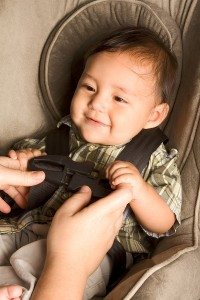What to look for when buying a child car seat
Keeping children safe in the car is a priority for all parents. Being sure they are securely strapped in and comfortable means peace of mind for the driver and can help to reduce stress on the road.
But with so many sizes and models available, choosing the right car seat for your child can seem confusing at first. With safety in mind, here are some of the things to look for before you make your choice.
Does it meet the regulations?
Child car seats are subject to strict regulations, designed to make them as safe as possible in the event of an accident. To help you check that a seat meets these safety standards look for the ‘E’ mark. This mark is a guarantee that the seat meets the UN Standard Regulation 44.03 or 44.04.
If car seats seem costly, you might be tempted to buy second-hand, but this could be a dangerous way to save money. If you can’t be certain of the seat’s history, you won’t know whether it meets current safety standards, or whether it has been in an accident that could have weakened it.
How will you use it?
Before you buy a car seat, think about how you plan to use it. You might need to move it in and out of the car on a regular basis, or perhaps move it from one car to another. In that case, you could consider choosing a lightweight seat.
If you’re planning longer journeys – perhaps to visit distant grandparents – a seat that reclines can help your child to sleep along the way.
Which type to choose?
Knowing your child’s weight and height is essential to finding the most suitable car seat. Weight is a more reliable indicator of size than age, which is why child seats are sold with weight guidelines.
- Babies up to 13kg will need a rearward-facing baby seat. These can be used in the front or the rear of the car, but the back seat is recommended as the safest option. If they are used in the front, you must disable the airbag.
- Once a baby has outgrown its rearward-facing seat, it’s time to look for a forward-facing child seat. These are made for children weighing 9kg-18kg. The integral harness in forward-facing seats helps to reduce the risk of injury in an accident and also stops the child sliding out of the seat.
- Children are ready for a booster seat or cushion when they weigh 15kg-36kg. If you’re looking for your child’s first booster seat, you might find that models with backs will provide a better fit for your car’s seat belt. Some also have side wings, designed to protect a child’s head in the event of an impact from the side.
Accidents
If you’re unfortunate enough to be involved in an accident, your child’s car seat will need to be replaced, even if it seems undamaged. It’s really a case of better safe than sorry, as the seat could have been weakened to the extent that it will no longer provide adequate protection.
So when buying car insurance, it’s a good idea to check whether the providers will cover the cost of replacement car seats in the event of an accident.
‘The above article was provided by Sainsbury’s Finance Family Blogger Network I received nopayment for posting this but may receive benefits from being part of the network.Author Bio:
Janet Chapman writes on a range of topics including family matters and car insurance. Her interests include cooking, the countryside and trying to train her large dog.
